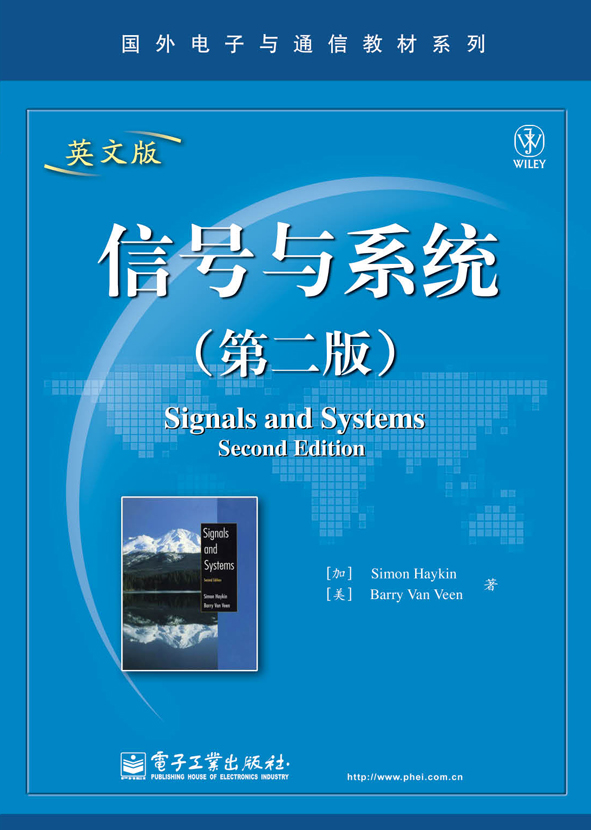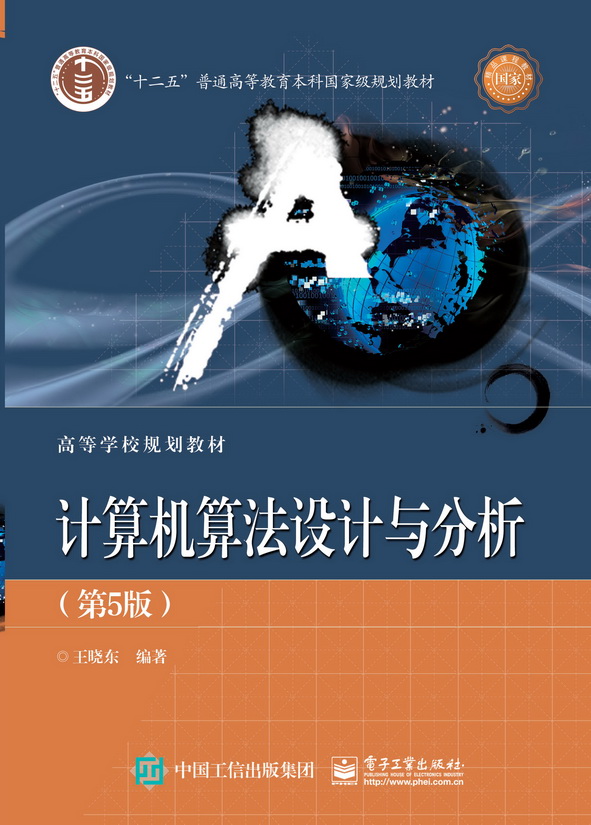信号与系统(第二版)(英文版)
作 译 者:(加)西蒙 赫金, (美)巴里 范维恩
出 版 日 期:2012-10-01
出 版 社:电子工业出版社
维 护 人:
书 代 号:G0185940
I S B N:9787121185946
图书简介:
本书可供英文原版教辅:习题解答,PPT;教辅申请咨询Email:Te_service@phei.com.cn。本书全面系统地介绍了信号与系统的基本概念、理论、方法及应用。全书共10章。第1章介绍了信号与系统的基本概念;第2章讨论了线性非时变系统的时域分析方法;第3、4章分别讨论了离散时间周期与非周期信号、连续时间周期与非周期信号,以及线性非时变系统的傅里叶描述以及傅里叶描述在混合信号类型中的应用;第6、7章分别讨论了连续时间信号与离散时间信号的复指数描述;第5、8、9章分别介绍了信号与系统在通信系统、滤波器与均衡器以及线性反馈系统中的应用;第10章简要说明若干关于非稳定信号以及非线性与时变系统的课题。
定价 89.0
您的专属联系人更多
联系人:李蕊
电话:010-88254558
邮箱:lir@phei.com.cn
-
配 套 资 源
-
图 书 内 容
内容简介
本书可供英文原版教辅:习题解答,PPT;教辅申请咨询Email:Te_service@phei.com.cn。 本书全面系统地介绍了信号与系统的基本概念、理论、方法及应用。全书共10章。第1章介绍了信号与系统的基本概念;第2章讨论了线性非时变系统的时域分析方法;第3、4章分别讨论了离散时间周期与非周期信号、连续时间周期与非周期信号,以及线性非时变系统的傅里叶描述以及傅里叶描述在混合信号类型中的应用;第6、7章分别讨论了连续时间信号与离散时间信号的复指数描述;第5、8、9章分别介绍了信号与系统在通信系统、滤波器与均衡器以及线性反馈系统中的应用;第10章简要说明若干关于非稳定信号以及非线性与时变系统的课题。图书详情
ISBN:9787121185946开 本:16开页 数:820字 数:1706本书目录
Preface CHAPTER 1 Introduction 1.1 What Is a Signal? 1.2 What Is a System? 1.3 Overview of Specific Systems 1.4 Classification of Signals 1.5 Basic Operations on Signals 1.6 Elementary Signals 1.7 Systems Viewed as Interconnections of Operations 1.8 Properties of Systems 1.9 Noise 1.10 Theme Examples 1.11 Exploring Concepts with MATLAB 1.12 Summary Further Reading Additional Problems CHAPTER 2 Time-Domain Representations of Linear Time-Invariant Systems 2.1 Introduction 2.2 The Convolution Sum 2.3 Convolution Sum Evaluation Procedure 2.4 The Convolution Integral 2.5 Convolution Integral Evaluation Procedure 2.6 Interconnections of LTI Systems 2.7 Relations between LTI System Properties and the Impulse Response 2.8 Step Response 2.9 Differential and Difference Equation Representations of LTI Systems 2.10 Solving Differential and Difference Equations 2.11 Characteristics of Systems Described by Differential and Difference Equations 2.12 Block Diagram Representations 2.13 State-Variable Descriptions of LTI Systems 2.14 Exploring Concepts with MATLAB 2.15 Summary Further Reading Additional Problems CHAPTER 3 Fourier Representations of Signals and Linear Time-Invariant Systems 3.1 Introduction 3.2 Complex Sinusoids and Frequency Response of LTI Systems 3.3 Fourier Representations for Four Classes of Signals 3.4 Discrete-Time Periodic Signals: The Discrete-Time Fourier Series 3.5 Continuous-Time Periodic Signals: The Fourier Series 3.6 Discrete-Time Nonperiodic Signals: The Discrete-Time Fourier Transform 3.7 Continuous-Time Nonperiodic Signals: The Fourier Transform 3.8 Properties of Fourier Representations 3.9 Linearity and Symmetry Properties 3.10 Convolution Property 3.11 Differentiation and Integration Properties 3.12 Time- and Frequency-Shift Properties 3.13 Finding Inverse Fourier Transforms by Using Partial-Fraction Expansions 3.14 Multiplication Property 3.15 Scaling Properties 3.16 Parseval Relationships 3.17 Time–Bandwidth Product 3.18 Duality 3.19 Exploring Concepts with MATLAB 3.20 Summary Further Reading Additional Problems CHAPTER 4 Applications of Fourier Representations to Mixed Signal Classes 4.1 Introduction 4.2 Fourier Transform Representations of Periodic Signals 4.3 Convolution and Multiplication with Mixtures of Periodic and Nonperiodic Signals 4.4 Fourier Transform Representation of Discrete-Time Signals 4.5 Sampling 4.6 Reconstruction of Continuous-Time Signals from Samples 4.7 Discrete-Time Processing of Continuous-Time Signals 4.8 Fourier Series Representations of Finite-Duration Nonperiodic Signals 4.9 The Discrete-Time Fourier Series Approximation to the Fourier Transform 4.10 Efficient Algorithms for Evaluating the DTFS 4.11 Exploring Concepts with MATLAB 4.12 Summary Further Reading Additional Problems CHAPTER 5 Application to Communication Systems 5.1 Introduction 5.2 Types of Modulation 5.3 Benefits of Modulation 5.4 Full Amplitude Modulation 5.5 Double Sideband-Suppressed Carrier Modulation 5.6 Quadrature-Carrier Multiplexing 5.7 Other Variants of Amplitude Modulation 5.8 Pulse-Amplitude Modulation 5.9 Multiplexing 5.10 Phase and Group Delays 5.11 Exploring Concepts with MATLAB 5.12 Summary Further Reading Additional Problems CHAPTER 6 Representing Signals by Using Continuous-Time Complex Exponentials: the Laplace Transform 6.1 Introduction 6.2 The Laplace Transform 6.3 The Unilateral Laplace Transform 6.4 Properties of the Unilateral Laplace Transform 6.5 Inversion of the Unilateral Laplace Transform 6.6 Solving Differential Equations with Initial Conditions 6.7 Laplace Transform Methods in Circuit Analysis 6.8 Properties of the Bilateral Laplace Transform 6.9 Properties of the Region of Convergence 6.10 Inversion of the Bilateral Laplace Transform 6.11 The Transfer Function 6.12 Causality and Stability 6.13 Determining the Frequency Response from Poles and Zeros 6.14 Exploring Concepts with MATLAB 6.15 Summary Further Reading Additional Problems CHAPTER 7 Representing Signals by Using Discrete-Time Complex Exponentials: the z-Transform 7.1 Introduction 7.2 The z-Transform 7.3 Properties of the Region of Convergence 7.4 Properties of the z-Transform 7.5 Inversion of the z-Transform 7.6 The Transfer Function 7.7 Causality and Stability 7.8 Determining the Frequency Response from Poles and Zeros 7.9 Computational Structures for Implementing Discrete-Time LTI Systems 7.10 The Unilateral z-Transform 7.11 Exploring Concepts with MATLAB 7.12 Summary Further Reading Additional Problems CHAPTER 8 Application to Filters and Equalizers 8.1 Introduction 8.2 Conditions for Distortionless Transmission 8.3 Ideal Low-Pass Filters 8.4 Design of Filters 8.5 Approximating Functions 8.6 Frequency Transformations 8.7 Passive Filters 8.8 Digital Filters 8.9 FIR Digital Filters 8.10 IIR Digital Filters 8.11 Linear Distortion 8.12 Equalization 8.13 Exploring Concepts with MATLAB 8.14 Summary Further Reading Additional Problems CHAPTER 9 Application to Linear Feedback Systems 9.1 Introduction 9.2 What Is Feedback 9.3 Basic Feedback Concepts 9.4 Sensitivity Analysis 9.5 Effect of Feedback on Disturbance or Noise 9.6 Distortion Analysis 9.7 Summarizing Remarks on Feedback 9.8 Operational Amplifiers 9.9 Control Systems 9.10 Transient Response of Low-Order Systems 9.11 The Stability Problem 9.12 Routh–Hurwitz Criterion 9.13 Root Locus Method 9.14 Nyquist Stability Criterion 9.15 Bode Diagram 9.16 Sampled-Data Systems 9.17 Exploring Concepts with MATLAB 9.18 Summary Further Reading Additional Problems CHAPTER 10 Epilogue 10.1 Introduction 10.2 Speech Signals: An Example of Nonstationarity 10.3 Time–Frequency Analysis 10.4 Nonlinear Systems 10.5 Adaptive Filters 10.6 Concluding Remarks Further Reading APPENDIX A Selected Mathematical Identities APPENDIX B Partial-Fraction Expansions APPENDIX C Tables of Fourier Representations and Properties APPENDIX D Tables of Laplace Transforms and Properties APPENDIX E Tables of z-Tansforms and Properties APPENDIX F Introduction to MATLAB Index展开前 言
Preface The “Signals and Systems” Course in the Electrical Engineering Undergraduate Curriculum A course on “signals and systems” is fundamental to the study of the many fields that constitute the ever-expanding discipline of electrical engineering. Signals and systems serves as the prerequisite for additional coursework in the study of communications, signal processing, and control. Given the pervasive nature of computing, concepts from signals and systems, such as sampling, are an important component of almost every electrical engineering field. Although the signals and systems that arise across these diverse fields are naturally different in their physical make-up and application, the principles and tools of signals and systems are applicable to all of them. An introductory course on “signals and systems”, commonly takes one of two forms: ● A one-semester course that focuses on the analysis of deterministic signals and an important class of systems known as linear time-invariant (LTI) systems, with practical examples drawn from communication and control systems. ● A two-semester course that expands on the one-semester course by including more detailed treatment of signal processing, communication and control systems. This course is usually offered at the sophomore or junior level and assumes the student has a background in calculus and introductory physics. How this Book Satisfies the Essential Needs of this Course Given the introductory nature of the signals and systems course and diversity of applications for the topic, the textbook must be easy to read, accurate, and contain an abundance of insightful examples, problems, and computer experiments to expedite learning the fundamentals of signals and systems in an effective manner. This book has been written with all of these objectives in mind. The second edition builds on the first edition’s success at providing a balanced and integrated treatment of continuous- and discrete-time forms of signals and systems. This approach has the pedagogical advantage of helping the student see the fundamental similarities and differences between continuous- and discrete-time representations and reflects the integrated nature of continuous- and discrete-time concepts in modern engineering practice. One consistent comment from users of the first edition and reviewers of the second is that the compelling nature of our approach becomes very apparent in Chapter 4 with the coverage of sampling continuous-time signals, reconstruction of continuous-time signals from samples, and other applications involving mixtures of different signal classes. The integrated approach is also very efficient in covering the large range of topics that are typically required in a signals and systems course. For example, the properties of all four Fourier representations are covered side-by-side in Chapter 3. Great care has been taken in the presentation of the integrated approach to enhance understanding and avoid confusion. As an example of this, the four Fourier representations are treated in Chapter 3 as similar, yet distinct representations that apply to distinct signal classes. Only after the student has mastered them individually is the possibility of using Fourier representations to cross the boundaries between signal classes introduced in Chapter 4. Given the mathematical nature of signal representation and system analysis, it is rather easy for the reader to lose sight of their practical application. Chapters 5, 8, and 9 deal with applications drawn from the fields of communication systems, design of filters, and control systems in order to provide motivation for the reader. In addition, considerable effort has been expended in the second edition to provide an application focus throughout the tool-oriented chapters by including an abundance of application-oriented examples. A set of six theme examples, introduced in Chapter 1 and revisited throughout the remaining chapters, is used to show how different signal representation and system analysis tools provide different perspectives on the same underlying problem. The theme examples have been selected to sample the broad range of applications for signals and systems concepts. The text has been written with the aim of offering maximum teaching flexibility in both coverage and order of presentation, subject to our philosophy of truly integrating continuous- and discrete-time concepts. When continuous- and discrete-time concepts are introduced sequentially, such as with convolution in Chapter 2 and Fourier representations in Chapter 3, the corresponding sections have been written so that the instructor may present either the continuous- or discrete-time viewpoint first. Similarly, the order of Chapters 6 and 7 may be reversed. A two-semester course sequence would likely cover most, if not all, of the topics in the book. A one-semester course can be taught in a variety of ways, depending on the preference of the instructor, by selecting different topics. Structure Designed to Facilitate and Reinforce Learning A variety of features have been incorporated into the second edition to facilitate and reinforce the learning process. We have endeavored to write in a clear, easy to follow, yet precise manner. The layout and format has been chosen to emphasize important concepts. For example, key equations and procedures are enclosed in boxes and each example is titled. The choice and layout of figures has been designed to present key signals and systems concepts graphically, reinforcing the words and equations in the text. A large number of examples are included in each chapter to illustrate application of the corresponding theory. Each concept in the text is demonstrated by examples that emphasize the sequence of mathematical steps needed to correctly apply the theory and by examples that illustrate application of the concepts to real-world problems. An abundance of practice is required to master the tools of signals and systems. To this end, we have provided a large number of problems with answers immediately following introduction of significant concepts, and a large number of problems without answers at the end of each chapter. The problems within the chapters provide the student with immediate practice and allow them to verify their mastery of the concept. The end of the chapter problems offer additional practice and span a wide range of difficulty and nature, from drilling basic concepts to extending the theory in the text to new applications of the material presented. Each chapter also contains a section illustrating how MATLAB, acronym for MATrix LABoratory and product of The Math Works, Inc., may be used to explore concepts and test system designs within the context of a “Software Laboratory”. A complementary set of computer-oriented end of chapter problems is also provided. New to the Second Edition of the Book In general terms, this new edition of the book follows the organization and philosophy of the first edition. Nevertheless, over and above new examples and additional problems, some important changes have been made to the book. In addition to the layout and format improvements noted above, long sections in the first edition have been broken up into smaller units. The significant changes to each chapter are summarized as follows: ● Chapter 1: Two new sections, one on Theme Examples and the other on electrical noise, have been added. The Theme Examples, six in number, illustrate the broad range of problems to which signals and systems concepts apply and provide a sense of continuity in subsequent chapters of the book by showing different perspectives on the same problem. Two new subsections, one on MicroElectroMechanical Systems (MEMS) and the other on derivatives of the unit-impulse function, have also been added. ● Chapter 2: The treatment of discrete- and continuous-time convolution has been reorganized into separate, yet parallel sections. The material introducing the frequency response of LTI systems has been removed and incorporated into Chapter 3. The treatment of differential and difference equations has been expanded to clarify several subtle issues. ● Chapter 3: The chapter has been written with increased emphasis on applications of Fourier representations for signals through the introduction of new examples, incorporation of filtering concepts contained in Chapter 4 of the first edition, and reordering the presentation of properties. For example, the convolution property is presented much earlier in the second edition because of its practical importance. Derivations of the discrete-time Fourier series, Fourier series, and discrete-time Fourier transform have been removed and incorporated as advanced problems. ● Chapter 4: The focus has been tightened as reflected by the new title. Material on frequency response of LTI systems has been moved to Chapter 3 and advanced material on interpolation, decimation, and fast convolution has been removed and incorporated as advanced problems. ● Chapter 5: A new section on the Costas receiver for demodulation of double sideband-suppressed carrier modulated signals has been added. ● Chapter 6: The definition of the unilateral Laplace transform has been modified to include impulses and discontinuities at and the material on Bode diagrams in Chapter 9 of the first edition is now incorporated in the discussion of graphical evaluation of frequency response. ● Chapter 9: A new section on the fundamental notion of feedback and “why feedback?” has been introduced. Moreover, the treatment of feedback control systems has been shortened, focusing on the fundamental issue of stability and its different facets. ● Chapter 10: The epilogue has been completely rewritten. In particular, more detailed treatments of wavelets and the stability of nonlinear feedback systems have been introduced. ● Appendix F: This new appendix presents a tutorial introduction to MATLAB. Supplements The following supplements are available from the publishers website: www.wiley.com/college/haykin PowerPoint Slides: Every illustration from the text is available in PowerPoint format enabling instructors to easily prepare lesson plans. Solutions Manual: An electronic Solutions Manual is available for download from the website. If a print version is required, it may be obtained by contacting your local Wiley representative. Your representative may be determined by finding your school on Wiley’s CONTACT/Find a Rep webpages. MATLAB resources: M-files for the computer-based examples and experiments are available. About the Cover of the Book The cover of the book is an actual photograph of Mount Shasta in California. This picture was chosen for the cover to imprint in the mind of the reader a sense of challenge, exemplified by the effort needed to reach the peak of the Mount, and a sense of the new vistas that result from climbing to the peak. We thus challenge the reader to master the fundamental concepts in the study of signals and systems presented in the book and promise that an unparalleled viewpoint of much of electrical engineering will be obtained by rising to the challenge. In Chapter 1 we have included an image of Mount Shasta obtained using a synthetic aperture radar (SAR) system. A SAR image is produced using many concepts from the study of signals and systems. Although the SAR image corresponds to a different view of Mount Shasta, it embodies the power of signals and systems concepts for obtaining different perspectives of the same problem. We trust that motivation for the study of signals and systems begins with the cover. Acknowledgments In writing the second edition, we have benefited enormously from insightful suggestions and constructive input received many instructors and students that used the first edition, anonymous reviewers, and colleagues. We are deeply grateful to Professor Aziz Inan of University of Portland for carefully reading the entire manuscript for both accuracy and readability and making innumerable suggestions to improve the presentation. In addition, the following colleagues have generously offered detailed input on the second edition: ● Professor Yogesh Gianchandani, University of Michigan ● Professor Dan Cobb, University of Wisconsin ● Professor John Gubner, University of Wisconsin ● Professor Chris Demarco, University of Wisconsin ● Professor Leon Shohet, University of Wisconsin ● Mr. Jacob Eapen, University of Wisconsin ● Dr. Daniel Sebald We are grateful to them all for helping us in their own individual ways shape the second edition into its final form. Barry Van Veen is indebted to his colleagues at the University of Wisconsin for the opportunity to regularly teach the Signals and Systems class. Simon Haykin thanks his students, past and present, for the pleasure of teaching them and conducting research with them. We thank the many students at both McMaster and Wisconsin, whose suggestions and questions have helped us over the years to refine and in some cases rethink the presentation of the material in the book. In particular, we thank Chris Swickhamer and Kris Huber for their invaluable help in preparing some of the computer experiments, the Introduction to MATLAB, the solutions manual, and in reviewing page proofs. Bill Zobrist, Executive Editor of Electrical Engineering texts, has skillfully guided the second edition from conception to completion. We are grateful for his strong support, encouragement, constructive input, and persistence. We thank Caroline Sieg for dexterously managing the production process under a very tight schedule, and Katherine Hepburn (Senior Marketing Manager) for her creative promotion of the book. We are indebted to Fran Daniele and her staff of Preparé Inc. for their magnificent job in the timely production of the book; it was a pleasure to work with them. Lastly, Simon Haykin thanks his wife Nancy, and Barry Van Veen thanks his wife Kathy and children Emily, David, and Jonathan for their support and understanding throughout the long hours involved in writing this book. Simon Haykin Barry Van Veen展开作者简介
本书暂无作者简介 -
样 章 试 读本书暂无样章试读!
-
图 书 评 价 我要评论








